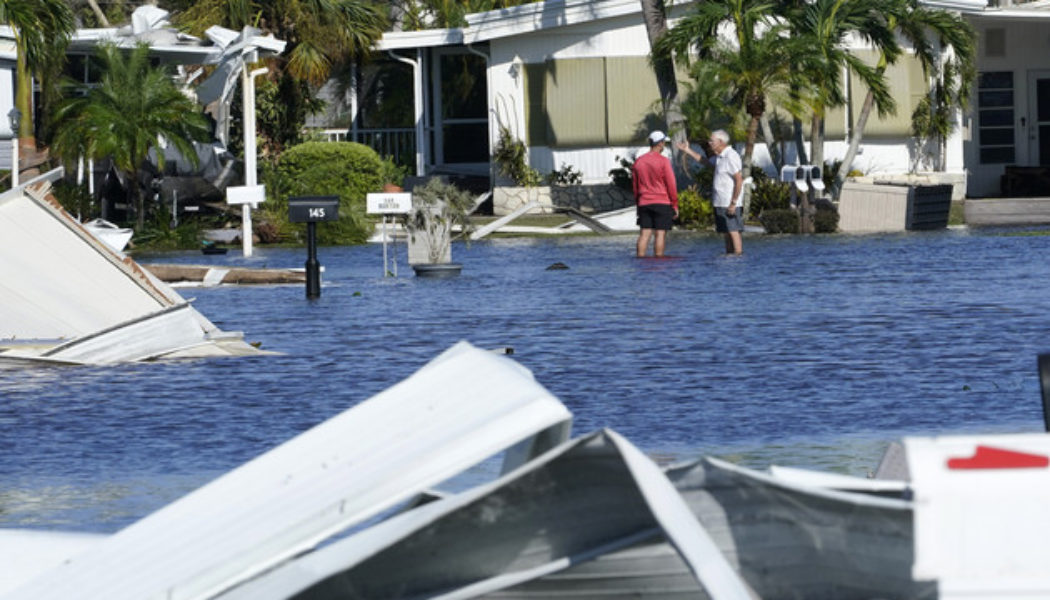“No pun intended: This is the perfect storm,” said Chris Brown, executive director of the disaster policy group SmarterSafer Coalition.
The price tag from Ian’s destruction will easily reach the tens of billions of dollars, insurance experts say. Early projections from after Ian’s landfall showed overall insured losses alone topping $30 billion, said Mark Friedlander, a spokesperson with the Insurance Information Institute. Much of that will be from flooding, said RMS, an analytics firm that’s part of credit-rating agency Moody’s.
“Just because you’re not in a ‘flood zone’ does not mean that you’re not at risk of a catastrophic event like this,” Florida Gov. Ron DeSantis, a Republican, said during a briefing Wednesday. “This is an issue we’re going to have to deal with.”
“You’re looking at a storm that’s changed the character of a significant part of our state,” DeSantis added Thursday. He described the hurricane as a “500-year flood event.”
Lack of flood insurance coverage will make rebuilding more costly. While Floridians are more insured than any other state against deluges, just 18 percent of homeowners have coverage through the federally run National Flood Insurance Program. Those federal policies also only cover up to $250,000 in damage — far below the Realtor.com-listed median home sale price of $387,500 in Lee County, where Ian made landfall — and do not include living expenses, which can pile up after disasters.
“These families have no financial protection from flood losses,” Friedlander said of the 80-plus percent of Floridians without flood insurance. “Many families, perhaps thousands of families, will be devastated.”
President Joe Biden said Thursday that the federal government would try to ease the financial burden by offering up to $75,000 for home repairs. FEMA will also provide recovery assistance.
Yet to make matters worse, many Floridians dropped federal flood insurance before the storm. The number of Florida policies declined nearly 3 percent, roughly 48,000 homes, after the Federal Emergency Management Agency rolled out a new pricing system in October meant to more accurately price the dangers, said Matthew Eby, president of the First Street Foundation, which analyzes flood risk. Many premiums in Florida rose, and the data suggest homeowners ditched coverage.
Other residents may have thought they didn’t need flood insurance, because of outdated FEMA flood maps that don’t account for future climate change. People with federally backed mortgages are required to purchase flood insurance if they live in the 100-year floodplain. Purchasing flood insurance outside of that area is optional, though those areas still face flood risk — one-quarter of claims come from outside the 100-year floodplain, according to FEMA.
FEMA’s maps also often don’t incorporate the emerging science about the link between climate change and more intense hurricanes. Some scientists believe that warmed ocean waters caused Ian and previous hurricanes, such as Harvey in 2017, to rapidly accelerate before landfall and bring torrents of rainfall in areas further inland. There, the storms encountered people who were less likely to have bought flood insurance than people living on the coasts or in the 100-year floodplain.
A rapid analysis by climate scientists found that climate change probably increased Ian’s extreme rain rates by 10 percent compared with a world without human-caused, planet-warming gases.
“[Flood insurance requirements] miss a whole subset of properties,” Eby said. “Hurricanes are not what they used to be. They intensify much more rapidly.”
Some of the counties hardest hit by Ian underscore the issue. First Street Foundation estimated that more than 50,087 properties in Charlotte County — the jurisdiction that includes Port Charlotte and Punta Gorda — are at risk for flooding, but they are not among the 102,675 properties in FEMA’s 100-year floodplain. That means the federal maps missed a third of the properties they should have included.
In Lee County, home to Sanibel and Fort Myers, 48,587 properties outside FEMA’s 100-year floodplain should be considered flood-prone.
Florida, however, might be better prepared than other states, said Laura Lightbody, who directs the Pew Charitable Trusts’ flood-prepared communities initiative. Many counties there incorporate new climate data into their floodplain maps, she said. Its post-Andrew building codes, designed with hurricanes in mind, are considered best-in-class — their performance “will certainly be studied,” she added. Florida has more flood insurance policies than any other state.
Yet the heavy rainfall from Ian that lashed inland communities in Florida, akin to the downpours that swamped Houston during Hurricane Harvey in 2017, offers a cautionary note about the expanding reach of floods.
“The fear is that’s what is going to play out here: That the rain from Hurricane Ian is going to most impact communities that are either inland or traditionally not impacted by the hurricane events that typically impact Florida — and who typically don’t carry flood insurance,” Lightbody said.
Neptune Flood, a private flood insurance company with 130,000 policyholders, saw four times the number of people requesting flood insurance policies compared with its normal level on Monday as Ian traveled northward. About half of its sales are not in the 100-year floodplain, and uptake usually spikes after disasters, said Trevor Burgess, the firm’s CEO. So do premiums.
Burgess said flood coverage has gotten more expensive over Neptune’s five years of existence given new data points showing increasing severity and frequency from flooding. He expects that trend to continue, which will prompt rethinking about whether it is wise to rebuild or live in the floodplain.
“Developers, consumers will start to ask the question, ‘Does it really make sense to pay $5,000 or $8,000 or $10,000 a year for flood insurance? Or should we build higher? Or should we build more inland?’” he said. “And that over time we will have less building in these coastal, high-hazard areas.”
Florida already was in poor shape for this type of storm. Six homeowners’ property insurers reached insolvency this year, the most since Hurricane Andrew pushed droves of them out of the state in 1992, the Insurance Information Institute’s Friedlander said. The state has 27 other companies on its watch list. Ian could push more to the brink, he said.
The dearth of private property insurance in Florida means many homeowners have no choice but to buy their homeowners’ and wind-storm policies from the state-created Citizens Property Insurance Corp., the insurer of last resort that explicitly does not cover flood damage. Many homeowners complain that Citizens’ policies are barely affordable.
Those pressures, Friedlander said, are forcing some homeowners to sell their homes. Rising real estate and materials prices also mean many homeowners will find that the insurance payout for replacing their home is inadequate, he said.
“Eventually this is going to catch up with the market and cause values of homes to decline,” Friedlander said.
Southwest Florida real estate boomed over the last two years as more people flocked to the coast, where the median sales price fetches $327,100, a nearly 19 percent increase from August 2021, according to Rocket Homes.
Still, signals appearing in disaster-prone communities nationwide may show a reversal is coming, said Dave Burt, CEO of the investment research firm DeltaTerra Capital. Year over year, home sales have declined 19 percent through May in the United States’ 100-year floodplain and 22 percent in wildfire-prone areas, compared with a 15-percent average decline across the country. He said much of that is owed to steeper insurance rates and improved perceptions of the risks that climate change poses to housing.
Taken together, rising insurance costs and higher interest rates from the Federal Reserve’s inflation-fighting push means fewer investors could be willing to buy and flip flooded properties, Burt said, removing a major off-ramp for homeowners from past disasters. That could deepen the spiral, he said.
“There’s probably going to be a lot of strategic defaults,” Burt said. “They’re going to migrate. They’re going to leave.”
When Burt’s firm ran an analysis last year of metropolitan areas at greatest risk to a disaster-fueled repricing that depressed home values, the Cape Coral and Fort Myers, Fla., metro area in Lee County topped the list. As insurance costs rise, home values are likelier to fall, which could send ripples throughout markets, he said.
“In the past, what we’ve seen is economies and importantly real estate markets have been able to absorb these types of events,” Burt said. That’s because past disasters have not changed people’s long-term expectations for ownership costs, he added. “I think that might change this time around.”
[flexi-common-toolbar] [flexi-form class=”flexi_form_style” title=”Submit to Flexi” name=”my_form” ajax=”true”][flexi-form-tag type=”post_title” class=”fl-input” title=”Title” value=”” required=”true”][flexi-form-tag type=”category” title=”Select category”][flexi-form-tag type=”tag” title=”Insert tag”][flexi-form-tag type=”article” class=”fl-textarea” title=”Description” ][flexi-form-tag type=”file” title=”Select file” required=”true”][flexi-form-tag type=”submit” name=”submit” value=”Submit Now”] [/flexi-form]









